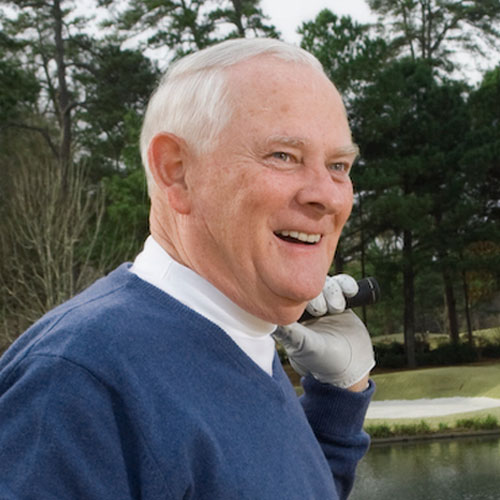It’s 85 miles from Montgomery to Laurens’s hometown. Laurens made the trip there and back, every weekday, for 5 ½ weeks of TomoTherapy® treatments. He’ll be the first to tell you it was worth every mile, and every minute.
A name like Laurens comes with history. One ancestor signed the Declaration of Independence. Others trace leadership in the Montgomery, Alabama community back to pre-Civil War years. In spring of 2006, Laurens was looking forward to continued, active presence in Montgomery’s business community and a long future enjoying family and friends. Then, a series of Prostate Specific Antigen (PSA) screening tests showed rising PSA levels. And, fearing prostate cancer, Laurens asked for a biopsy.
Laurens was shocked when he received the results. “They took 17 tissue samples and all 17 were malignant,” recalls Laurens. A Gleason score was calculated, giving a grade or level to the extent of the cancer found in the prostate.
“My Gleason score was 8. The doctor said 80% of prostate cancer patients have a Gleason score of 6 or less. I was in trouble!”
Laurens’s oncologist agreed. “Laurens presented with high-risk prostate cancer. It was fast-growing and aggressive,” says University of Alabama at Birmingham (UAB) Associate Professor of Radiation Oncology Dr. John B. Fiveash.
“This was serious,” Laurens says, “For the first 10 days I was in mortal shock. I couldn’t stop thinking, I have cancer.”
Laurens, who describes himself as “medically proactive,” wanted information. His son-in-law, a regional manager for the oncology division of an international company and a son in the medical equipment profession gathered information from colleagues and clients. Laurens knew his situation was high risk and wanted the best options for treatment.
“The name TomoTherapy and Dr. John Fiveash kept coming up,” Laurens says. Immediately, he made an appointment with Dr. Fiveash at the Kirklin Clinic in Birmingham, 85 miles up I-65 from Montgomery.
“Dr. Fiveash gave it to me straight,” Laurens says. “Radiation treatment was my only option…They’d do adjuvant [hormone] therapy to shrink the tumor. Then radiation….I was told to expect chemotherapy afterward because of the tumor size and the way the cancer had spread….I felt like a guy who’d been in a car wreck…but I knew I had to be positive.” Also, Laurens was determined to learn as much as possible about the disease so he could make informed, confident decisions about his own care.
“The clinic had a handbook for patients telling you what to expect from radiation,” he recalls, “They list all these horrible things to expect…exhaustion, feeling sick…even lifelong side effects like bladder problems and rectal bleeding.”
“Dr. Fiveash said, ‘Throw that book away. That was printed before we had the TomoTherapy machine.”
Because Laurens had advanced prostate cancer, Dr. Fiveash recommended treatment using the TomoTherapy® Hi·Art® treatment system at the Kirklin Clinic.
“There are so many advantages to TomoTherapy,” Dr. Fiveash says.
“First, [the machine allows us to do] daily image guidance. We know, at every session, the exact location of the tumor and surrounding healthy tissue. This allows us to deliver more radiation to the prostate because we’re able to treat more accurately with lower toxicity.”
As a result, Dr. Fiveash was able to complete Laurens’s radiation therapy regimen in just 5 ½ weeks. Radiation therapy with conventional technology can take 8 to 9 weeks. And, without daily CT scans, radiation is directed toward a tumor based on radio opaque markers and data from periodic scans. If a tumor has shrunk or changed location, radiation could be incorrectly directed to healthy tissue.
By pairing CT scanning with a unique, 360 degree “helical” delivery of radiation, the TomoTherapy Hi·Art treatment system is equipped to deliver radiation to multiple sites in a single session. Dr. Fiveash describes this capability as a great advantage for treatment of advanced prostate cancer.
“TomoTherapy allows us to treat the lymph nodes and prostate at the same time, but, with a different amount of radiation to each….Other systems require 8 to 9 weeks. First, 5 ½ weeks with same amount of radiation to both the prostate and lymph nodes. Then, another 3 weeks to the prostate alone.”
The result? According to Dr. Fiveash, the 5 ½ week regimen with the TomoTherapy treatment system is not only more convenient for the patient, but more radiation is delivered to cancerous tissue with fewer and less severe side effects for surrounding healthy tissue.
“I’ve treated about 100 patients with the TomoTherapy machine…about 250 a year total in the clinic,” says Dr. Fiveash. “We’ve just completed a study of the first 30 patients where treatment included both prostate and lymph nodes…Despite higher amounts of radiation per day, toxicity was actually lower.”
“Even though we used more radiation in a shorter time we saw less side effects, not more …because of the image guidance and accuracy of the TomoTherapy system,” Dr. Fiveash says. The study showed promising results, even for advanced, high-risk patients like Laurens.
“No patients showed severe – grade 3 or 4 – toxicity,” Dr. Fiveash explains. “Before Tomo, about 5 to 10 percent of patients had long term rectal bleeding.”
At age 65, Laurens knows many men treated with radiation therapy for prostate cancer. He was prepared for a grueling experience.
“My golfing buddy was treated with ‘old fashioned ordinary radiation’ at the same time. We’d compare notes every Sunday. He had diarrhea, lost his hair…and worse. I didn’t.”
“I felt like I was playing Monopoly and got Park Place, Boardwalk and Get Out of Jail Free!” Laurens says.
“During the whole time I was receiving Tomo treatments I never missed work. Never had a side effect. I drove 100 miles to the clinic every day and came back to work….I never even missed my Sunday golf!”
“It’s critically important to be able to accurately locate the prostate gland and tumor on a daily basis,” says Dr. Fiveash. “With TomoTherapy we can minimize the extent to which rectal and bladder tissues are affected – and the resulting side effects.”
Laurens completed the treatment plan. Hormone therapy reduced the tumor size. The 5 ½ weeks of radiation therapy with the TomoTherapy Hi·Art treatment system followed. Now, Dr. Fiveash has scheduled regular check-ups and ongoing adjuvant therapy.
“I was told to expect chemotherapy to clean up residual cancer cells because of the tumor size,” Laurens says. “I didn’t need it. For the past 19 check-ups, over the past 4 1/2 years, my PSA levels have been so low they’re undetectable. Less than 0.1! And, because the amount of radiation on the tissue around my prostate was so small, I don’t have those long-term side effects like so many men.”
Laurens is also enrolled in a 4-year UAB Hospital study of prostate cancer patients treated with Androgen therapy to reduce testosterone levels and suppress growth of cancer cells. His PSA levels will be monitored regularly.
“Now, I want to tell everybody about TomoTherapy,” Laurens says. “I about wore out my printer copying pages from their website to give to people.”
Today, Laurens rarely sees a week pass without talking with someone about prostate cancer and TomoTherapy. In fact, he estimates his informal support network has referred more than 65 men for treatment at Kirklin Clinic. “I’ve made it my purpose to get a closet subject with a lot of men out into the open. I’ve even told my urologist here in Montgomery.”
Laurens has now returned to the life he enjoyed before prostate cancer and TomoTherapy treatment. “It took a few months to stop dwelling on the cancer,” he says. “Now, I’ve put it behind me. I’m going to see my grandchildren graduate from college. And, in 10 years, I plan to still be out there playing golf!”



